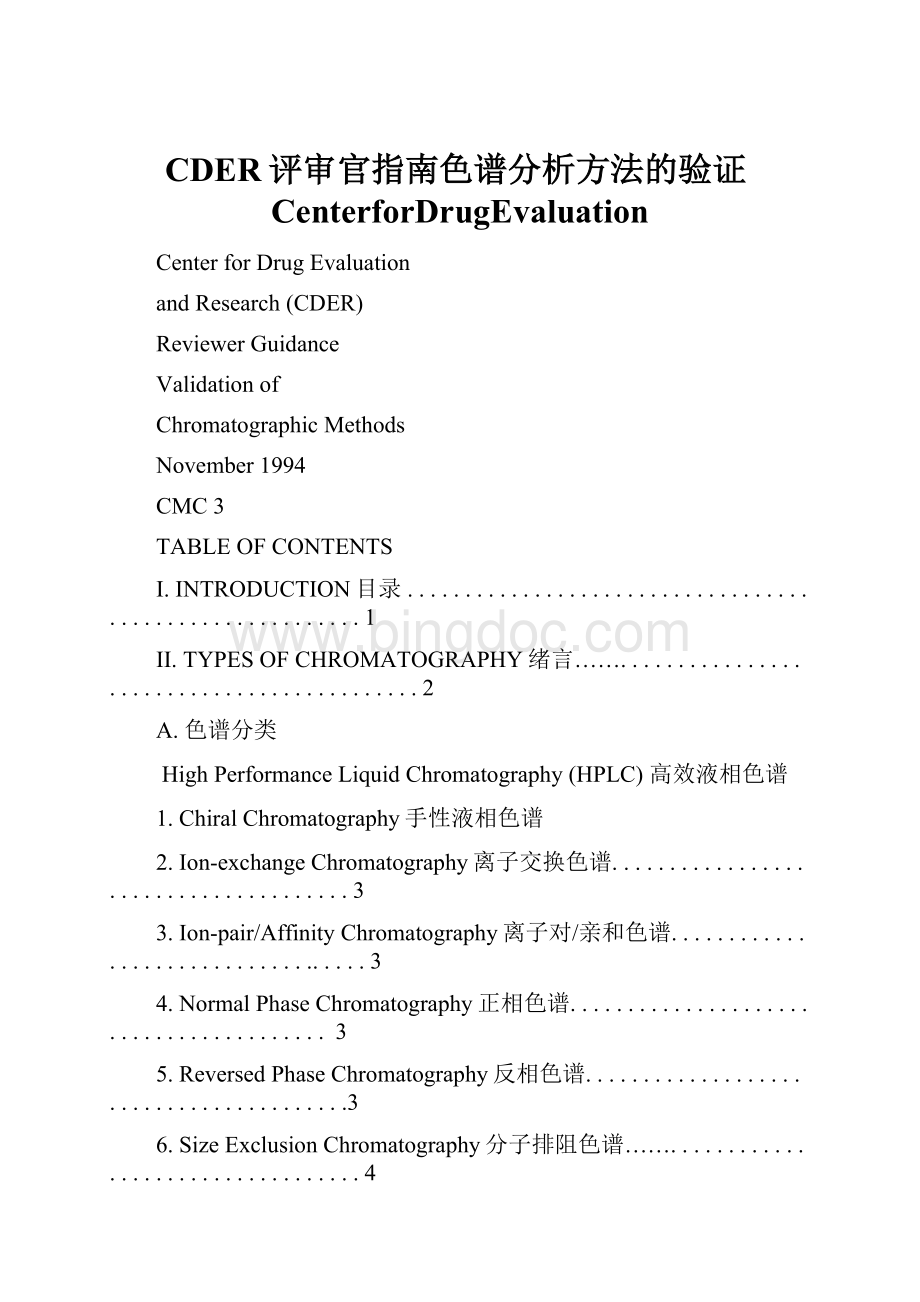CDER评审官指南色谱分析方法的验证CenterforDrugEvaluation.docx
《CDER评审官指南色谱分析方法的验证CenterforDrugEvaluation.docx》由会员分享,可在线阅读,更多相关《CDER评审官指南色谱分析方法的验证CenterforDrugEvaluation.docx(36页珍藏版)》请在冰点文库上搜索。

CDER评审官指南色谱分析方法的验证CenterforDrugEvaluation
CenterforDrugEvaluation
andResearch(CDER)
ReviewerGuidance
Validationof
ChromatographicMethods
November1994
CMC3
TABLEOFCONTENTS
I.INTRODUCTION目录.........................................................1
II.TYPESOFCHROMATOGRAPHY绪言……...........................................2
A.色谱分类
HighPerformanceLiquidChromatography(HPLC)高效液相色谱
1.ChiralChromatography手性液相色谱
2.Ion-exchangeChromatography离子交换色谱......................................3
3.Ion-pair/AffinityChromatography离子对/亲和色谱...................................3
4.NormalPhaseChromatography正相色谱........................................3
5.ReversedPhaseChromatography反相色谱........................................3
6.SizeExclusionChromatography分子排阻色谱……..................................4
B.GasChromatography(GC)气相色谱.......................………………………..4
C.Thin-LayerChromatography(TLC)薄层色谱...............…………………….....5
III.REFERENCESTANDARDS参考标准............................…………….....5
IV.PARAMETERSFORVALIDATIONOFHPLCHROMATOGRAPHICMETHODSFORDRUGSUBSTANCEANDDRUGPRODUCT药物及其制剂HPLC方法验证的参数………………….....7
A.Accuracy准确性………...............................……………………….........8
B.DetectionLimitandQuantitationLimit检出限和定量限.....………………………........8
C.Linearity线性…….........................................………………………..11
D.Precision精密度.........................................……………………….13
1.Repeatability重复性...................................……………………………13
a.InjectionRepeatability进样重复性...................…………………………………….13
b.AnalysisRepeatability分析重复性...................…………………………………….15
2.IntermediatePrecision组间精密度.......................……………………………..15
3.Reproducibility重现性................................………………………………16
E.Range范围……............................................……………………..16
F.Recovery回收率............................................……………………..16
G.Robustness耐久性..........................................…………………….16
H.SampleSolutionStability供试品溶液的稳定性.....................……………………...17
I.Specificity/selectivity专属性/选择性............................………………………17
J.SystemSuitabilitySpecificationsandTests系统适用性规定和试验....…….………………21
1.Capacityfactor容量因子...............................……………………………...22
2.Precision/Injectionrepeatability精密度/进样重复性...........…………………………….22
3.Relativeretention相对保留时间............................…………………………….22
4.Resolution分离度…….................................………………………………22
5.Tailingfactor拖尾因子...................................…………………………….23
6.Theoreticalplatenumber理论塔板数...................…..…………………………..26
K.GeneralPointstoConsider要点...............................…………………….28
V.COMMENTSANDCONCLUSIONS注解和结论.........................……………..29
VI.ACKNOWLEDGEMENTS致谢.................................…..…………….29
VII.REFERENCES参考文献..........................................…………….29
1ThisguidancehasbeenpreparedbytheAnalyticalMethodsTechnicalCommitteeoftheChemistryManufacturingControlsCoordinatingCommittee(CMCCC)oftheCenterforDrugEvaluationandResearchattheFoodandDrugAdministration.AlthoughthisguidancedoesnotcreateorconferanyrightsfororonanypersonanddoesnotoperatetobindFDAortheindustry,itdoesrepresenttheagency’scurrentthinkingonthevalidationofchromatographicmethods.Foradditionalcopiesofthisguidance,contacttheDivisionofCommunicationsManagement,HFD-210,CDER,FDA,5600FishersLane,Rockville,MD20857(Phone:
301-594-1012).Sendoneself-addressedadhesivelabeltoassisttheofficesinprocessingyourrequest.AnelectronicversionofthisguidanceisalsoavailableviaInternettheWorldWideWeb(WWW)(connecttotheFDAHomePageatandgotothe“RegulatoryGuidance”section).
REVIEWERGUIDANCE1VALIDATIONOFCHROMATOGRAPHICMETHODS
I.INTRODUCTION
Thepurposeofthistechnicalreviewguideistopresenttheissuestoconsiderwhenevaluatingchromatographictestmethodsfromaregulatoryperspective.ThedocumentdiscussesthepointstonoteandweaknessesofchromatographysothatCDERreviewerscanensurethatthemethod'sperformanceclaimsareproperlyevaluated,andthatsufficientinformationisavailableforthefieldchemisttoassessthemethod.Analyticalterms,asdefinedbytheInternationalConferenceofHarmonization(ICH),1993,havebeenincorporatedinthisguide.
本技术指南的目的是给审评人员审评验证色谱方法的,该文件讨论色谱方法的要点和不足,以便CDER的审评人员能够保证方法的良好性能,也使化学工作者了解为通过审评应给出的足够的信息。
国际协调会议(ICH)1993年定义的分析术语,已在这一指南中运用。
Chromatographicmethodsarecommonlyusedforthequantitativeandqualitativeanalysisofrawmaterials,drugsubstances,drugproductsandcompoundsinbiologicalfluids.Thecomponentsmonitoredincludechiralorachiraldrug,processimpurities,residualsolvents,excipientssuchaspreservatives,degradationproducts,extractablesandleachablesfromcontainerandclosureormanufacturingprocess,pesticideindrugproductfromplantorigin,andmetabolites.
色谱方法通常用于原料、药物、药物制剂和生物体液中化合物的定性和定量。
涉及的成分包括手性的或非手性的药物、过程杂质、残留溶媒、附加剂如防腐剂、分解产物、从容器和密闭包装或制造过程中带入的可提取和可过滤的杂质、植物药中的农药和代谢物等。
Theobjectiveofatestmethodistogeneratereliableandaccuratedataregardlessofwhetheritisforacceptance,release,stabilityorpharmacokineticsstudy.Dataaregeneratedforthequalitativeandquantitativetestingduringdevelopmentandpostapprovalofthedrugproducts.Thetestingincludestheacceptanceofrawmaterials,releaseofthedrugsubstancesandproducts,in-processtestingforqualityassurance,andestablishmentoftheexpirationdatingperiod.
试验方法的目的是得到可信赖的和准确的数据,无论是用于验收、出厂、稳定性或药物动力学研究。
得到的数据用于药品开发或批准后的定性和定量,试验包括原料的验收、药物和药物制剂的出厂、过程检验(In-processtesting)的质量保证和失效期的建立。
Validationofamethodistheprocessbywhichamethodistestedbythedeveloperoruserforreliability,accuracyandprecisenessofitsintendedpurpose.DatathusgeneratedbecomepartofthemethodsvalidationpackagesubmittedtoCDER.
方法的验证是由药品的开发者或使用者来检验其方法是否达到预期的可靠性、准确度和精密度的过程。
得到的数据成为方法的验证资料的一部分交给CDER.。
Methodsvalidationshouldnotbeaone-timesituationtofulfilAgencyfilingrequirements,butthemethodsshouldbevalidatedandalsodesignedbythedeveloperorusertoensureruggednessorrobustness.Methodsshouldbereproduciblewhenusedbyotheranalysts,onotherequivalentequipment,onotherdaysorlocations,andthroughoutthelifeofthedrugproduct.Datathataregeneratedforacceptance,release,stability,orpharmacokineticswillonlybetrustworthyifthemethodsusedtogeneratethedataarereliable.Theprocessofvalidationandmethoddesignalsoshouldbeearlyinthedevelopmentcyclebeforeimportantdataaregenerated.Validationshouldbeon-goingintheformofre-validationwithmethodchanges.
方法的验证对于完成机构满足档案要求不是一次性的,开发者和使用者都应验证其方法的耐用度或耐久性(ruggednessorrobustness.),其他的分析者、用其它相当的仪器,在其它的日期或地点,在药品生产期限(有效期)全过程,方法都应能够重现。
如果产生数据的方法是可靠的,那么所得到的验收、出厂、稳定性或药物动力学的数据就是可信赖的。
验证的过程和方法的设计应在开发过程中重要的数据产生之前,如果方法改变了,还应该再验证。
II.TYPESOFCHROMATOGRAPHY色谱类型
Chromatographyisatechniquebywhichthecomponentsinasample,carriedbytheliquidorgaseousphase,areresolvedbysorption-desorptionstepsonthestationaryphase.
色谱是一种技术,通过该技术,样品中的组分载入液相或气相中,通过在固定相上由吸附—解吸附来完成。
A.HighPerformanceLiquidChromatography(HPLC)高效液相色谱(HPLC)
HPLchromatographicseparationisbasedoninteractionanddifferentialpartitionofthesamplebetweenthemobileliquidphaseandthestationaryphase.Thecommonlyusedchromatographicmethodscanberoughlydividedintothefollowinggroups,notnecessarilyinorderofimportance:
HPLC分离是基于在样品在流动相液体和固定相之间的不同分配。
一般地说HPLC大体分为以下几种(未考虑其重要性顺序)
1.Chiral手性液相色谱
2.Ion--exchange离子交换色谱
3.Ion--pair/affinity离子对/亲和色谱
4.Normalphase正相色谱
5.Reversedphase反相色谱
6.Sizeexclusion分子排阻色谱
1.ChiralChromatography手性液相色谱
Separationoftheenantiomerscanbeachievedonchiralstationaryphasesbyformationofdiastereomersviaderivatizingagentsormobilephaseadditivesonachiralstationaryphases.Whenusedasanimpuritytestmethod,thesensitivityisenhancediftheenantiomericimpurityelutesbeforetheenantiomericdrug.
分离光学异构体可在手性固定相上,用衍生化试剂或在非手性固定相上用流动相添加剂形成非对对映体来实现。
用作杂质试验方法时,如果光学异构体杂质在光学异构体药物之前洗脱,要增加灵敏度。
2.Ion-exchangeChromatography离子交换色谱
Separationisbasedonthecharge-bearingfunctionalgroups,anionexchangeforsamplenegativeion(X-),orcationexchangeforsamplepositiveion(X+).GradientelutionbypHiscommon.
分离基于荷电功能团,样品负离子(X-)为阴离子,样品正离子((X+)为阳离子,一般用pH程序洗脱。
3.Ion-pair/AffinityChromatography离子对/亲和色谱
Separationisbasedonachemicalinteractionspecifictothetargetspecies.Themorepopularreversedphasemodeusesabufferandanaddedcounter-ionofoppositechargetothesamplewithseparationbeinginfluencedbypH,ionicstrength,temperature,concentrationo